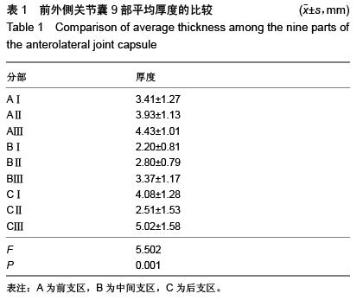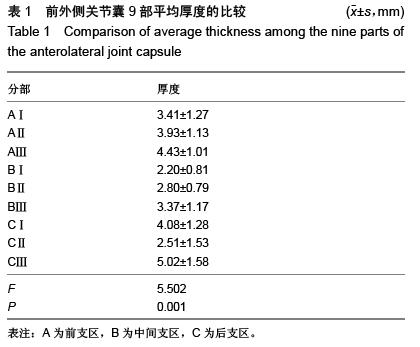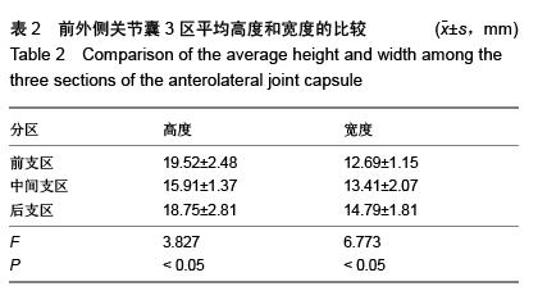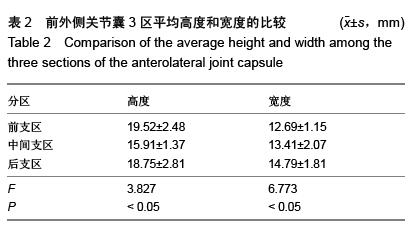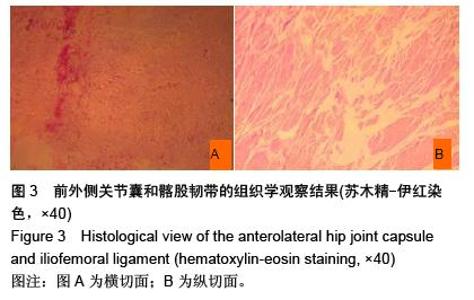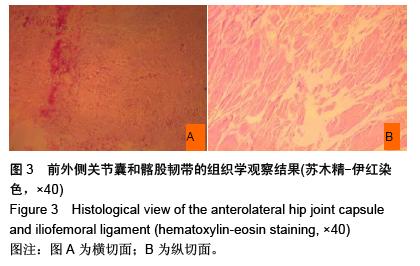| [1] 翟吉良,蔡思毅,翁习生.人工全髋关节置换术后脱位原因分析[J]. 中国矫形外科杂志, 2013, 21(1):58-60.
[2] Liao W, Trousdale RT, Ai S, et al. Dislocation After Total Hip Arthroplasty Among Patients With Developmental Dysplasia of the Hip. J Arthroplasty. 2012;27(5):764-769.
[3] 王仁,禹晓东,许向东,等.全髋关节置换术治疗股骨头坏死326髋疗效分析[J]. 实用医学杂志, 2013, 29(14):2353-2355.
[4] Morrey BF. Instability after total hip arthroplasty. World J Orthop. 2012;23(08):122-130.
[5] Domb BG, Philippon MJ, Giordano BD. Arthroscopic Capsulotomy, Capsular Repair, and Capsular Plication of the Hip: Relation to Atraumatic Instability. Arthroscopy. 2013; 29(1): 162-173.
[6] Boykin RE, Anz AW, Bushnell BD, et al. Hip Instability. J Am Acad Orthop Surg. 2011;19(6): 340-349.
[7] Dudda M, Gueleryuez A, Gautier E, et al. Risk Factors for Early Dislocation after Total Hip Arthroplasty: A Matched xase-control Study. J Orthop Surg. 2010;18(2): 179-183.
[8] Elkins JM, Stroud NJ, Rudert MJ, et al. The capsule's contribution to total hip construct stability - A finite element analysis. J Orthop Res. 2011;29(10): 1-7.
[9] Myers CA, Register BC, Lertwanich P, et al. Role of the Acetabular Labrum and the Iliofemoral Ligament in Hip Stability: An In Vitro Biplane Fluoroscopy Study. Am J Sports Med. 2011;39(1): 85-91.
[10] Prietzel T, Hammer N, Schleifenbaum S, et al. The impact of capsular repair on the dislocation rate after primary total hip arthroplasty: a retrospective analysis of 1972 cases. Zeitschrift Für Orthopädie Und Unfallchirurgie. 2014;152(2): 130-143.
[11] 李永奖,张力成,杨国敬,等.后方关节囊修补预防全髋关节置换术后早期脱位[J].中国矫形外科杂志,2006,14(12): 891-894.
[12] Fuss FK. New aspects of the morphology and function of the human hip joint ligaments. Am J Anatomy. 1991; 192(1): 1-13.
[13] Walters BL, Cooper JH, Rodriguez JA. New Findings in Hip Capsular Anatomy: Dimensions of Capsular Thickness and Pericapsular Contributions. Arthroscopy. 2014;30(10): 1235-1245.
[14] Cooper HJ, Walters BL, Rodriguez JA. Anatomy of the hip capsule and pericapsular structures: A cadaveric study. Clin Anat. 2015;28:665-671.
[15] 魏俊强,潘进社,张英泽,等.髂前下棘的解剖学研究及其在骨盆骨折中的应用[J].中国骨与关节损伤杂志, 2010, 25(4):309-311.
[16] Luenam S, Prugsawan K. Neural Anatomy of the Anterolateral Thigh Flap. J Hand Microsurg. 2015;7(1): 49-54.
[17] 唐举玉,李康华,任家伍,等.股外侧皮神经的形态特点与临床意义[J].中南大学学报:医学版, 2013, 37(12):1255-1259.
[18] 梅克海,胡月光.髋关节囊的应用解剖研究[J].贵州医药,2013,4 (4):359-360.
[19] Hang YT, Tang Y, Zhang C, et al. Modified posterior soft tissue repair for the prevention of early postoperative dislocation in total hip arthroplasty. Int Orthop. 2013;(37): 1039-1044.
[20] 王建,陈久毅,俞益火,等.小切口前外侧入路在髋关节置换术中的应用[J]. 中国中医骨伤科杂志, 2010, 18(10): 34-35.
[21] Sasaki M, Nagoya S, Kaya M, et al. Relationship between the hip joint capsule and piriformis tendon in a simulation of the modified Watson-Jones anterolateral approach in THA cadaver study. Acta Anaesthesiologica Scandinavica. 2013; 26(5): 610-613.
[22] Dixon MC, Scott RD, Schai PA, et al. A simple capsulorrhaphy in a posterior approach for total hip arthroplasty. J Arthroplasty. 2004;19(3): 373-376.
[23] Noble PC, Pfluger G.The optimal skin incision for minimally invasive total hip arthroplasty performed via the anterolateral approach. J Arthroplasty.2012;27(6):901-908.
[24] Philippon MJ, Michalski MP, Campbell KJ, et al. Surgically Relevant Bony and Soft Tissue Anatomy of the Proximal Femur. Orthop J Sports Med. 2014;2(6): 2.
[25] Hughes AW,Clark D,Carlino W,et al. Capsule repair may reduce dislocation following hip hemiarthroplasty through a direct lateral approach: a cadaver study. Bone Joint J. 2015; 97-B(1):141-144.
[26] Frank RM, Lee S, Bush-Joseph CA, et al. Improved outcomes after hip arthroscopic surgery in patients undergoing T-capsulotomy with complete repair versus partial repair for femoroacetabular impingement: a comparative matched-pair analysis. Am J Sports Med. 2014;42(11): 2634-2642.
[27] Sioen W, Simon JP, Labey L. Posterior Transosseous Capsulotendinous Repair in Total Hip Arthroplasty. J Bone Joint Surg. 2001;84(10): 1793-1798.
[28] McLawhorn AS, Potter HG. Posterior Soft Tissue Repair After Primary THA is Durable at Mid-term Followup: A Prospective MRI Study. Clin Orthop Relat Res. 2015;473(10): 3183-3189.
[29] 张鹏,孔杰,刘泽淼,等.全髋关节置换后外侧结构重建前后的生物力学变化[J].中华关节外科杂志:电子版, 2015, 6(6):68-71.
[30] White RE Jr, Forness TJ, Allman JK, et al. Effect of posterior capsular repair on early dislocation in primary total hip replacement. Clin Orthop Relat Res. 2001;(393): 163-167.
[31] 夏冰,朱丹杰,毕擎,等.全髋关节置换术中缝线锚入法修补后关节囊预防早期脱位[J].浙江医学, 2010, 32(7):1011-1013.
[32] Spaans EA, Spaans AJ, van den Hout JA, et al. The result of transmuscular versus transosseous repair of the posterior capsule on early dislocations in primary hip arthroplasty. Hip Int. 2015;25(6): 537-542.
[33] Kumar V, Sharma S, James J, et al. Total hip replacement through a posterior approach using a 22 mm diameter femoral head : the role of the transverse acetabular ligament and capsular repair in reducing the rate of dislocation. Bone Joint J. 2014;96-b(9):1202-1206.
[34] Shen N, Zhou G, Wang G. Comparison of Two Methods of Posterior Capsule Reconstruction upon Post-operative Hip Dislocation following Primary Total Hip Arthroplasty. J Pract Orthop. 2015;30(6Suppl):e20.
[35] 阙玉康,胡勇,丁辉,等. 保留关节囊的前外侧肌间隙入路微创全髋临床疗效分析[J].安徽医药, 2015,19 (9):1709-1713.
[36] 梁旭,刘粤,杨铁毅,等. 全髋关节置换术关节囊保留与否临床对比研究[J].国际骨科学杂志, 2014, 35(2):116-119.
[37] 冉学军,蒲川成,胡敏,等.保留修复后方关节囊及韧带对防止人工髋关节置换术后脱位的作用[J]. 临床骨科杂志, 2015, 18(3): 314-317.
[38] 杨先腾,田晓滨,孙立,等.保留关节囊人工髋关节置换术治疗高龄股骨颈骨折临床疗效探析[J].中国实用医药, 2015, 10(1):54-56.
[39] Amar E, Warschawski Y, Sampson TG, et al. Capsular Closure Does Not Affect Development of Heterotopic Ossification After Hip Arthroscopy. Arthroscopy. 2015;31(2): 225-230.
[40] 李琪,张力成,杨国敬,等.全髋关节置换扩大后路软组织修补关节囊切开线的解剖学研究[J].中国修复重建外科杂志, 2008, 22(7): 784-789. |
